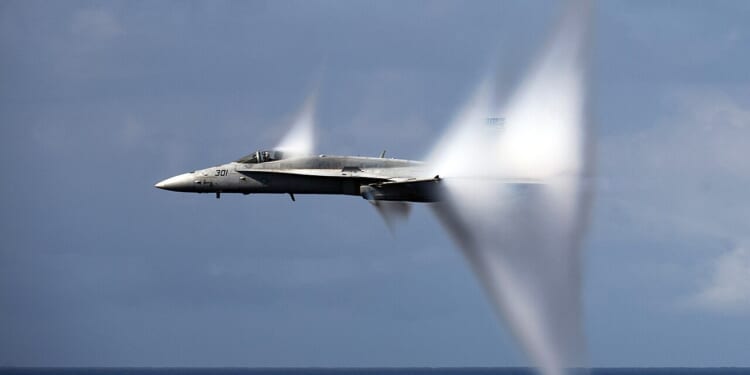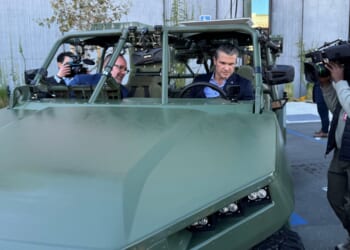The two fighters are tailored to the needs of their respective services; the F-16 is fast and lightweight, while the F/A-18 is better suited to carrier operations.
The General Dynamics F-16 Fighting Falcon and McDonnell Douglas F/A-18 Hornet will forever be linked in history. Both aircraft emerged from the US Air Force’s Lightweight Fighter (LTF) competition of the 1970s—an experiment in fielding a fighter that emphasized agility over power, then a departure from the prevailing aerospace trend of the time that emphasized power, resulting in the F-15, F-4, and F-111. By comparison, the LTF program sought lightweight, maneuverable, and affordable multirole fighters. Prototypes to aircraft that would become the F-16 and F/A-18 were both submitted. The Air Force selected the F-16, and the US Navy the F/A-18—forking the paths of two aircraft that are synonymous with US fourth-generation air power.
F-16 vs. F/A-18: A Head-to-Head Comparison
| Aircraft | F-16 Fighting Falcon (US Air Force) | F/A-18 Hornet (US Navy) |
| Year Introduced | 1978 | 1983 |
| Number Built | ~4,600, all variants | ~1,400–1,500, not including later Super Hornets |
| Length | 49 ft 5 in (15.06 m) | 56 ft (17.1 m) |
| Wingspan | 32 ft 8 in (9.96 m) | 40 ft 4 in (12.3 m) |
| Weight (MTOW) | ~37,500 lb (~17,000 kg); varies by block / configuration | ~51,000–52,000 lb (23,200–23,600 kg); varies by model and loadout |
| Engine(s) | One Pratt & Whitney F100 or GE F110 afterburning turbofan; thrust in ~23,000–29,000 lbf class depending on variant | Two General Electric F404 afterburning turbofans; ~30,000–36,000 lbf combined thrust |
| Top Speed | ~1,320 mph (~2,120 km/h) at altitude, depending on variant | ~1,190 mph (1,915 km/h) at altitude, depending on variant |
| Combat Radius | ~340–550 mi (550–885 km) | ~300–450 mi (480–725 km) |
| Service Ceiling | 50,000 ft (15,240 m) | 50,000 ft (15,240 m) |
| Loadout | One 20mm M61 Vulcan autocannon; ~11 external stations (varies by block); ~17,000 lb (7,700 kg) payload capacity | One internal 20mm autocannon; ~9 external hardpoints; ~13,000–14,000 lb (5,900–6,400 kg) payload capacity |
| Aircrew | 1 (2-seat trainer variant) | 1 (2-seat trainer and strike variants) |
The F-16 and F/A-18 Have Different Flight Characteristics
The F-16’s design philosophy was aerodynamic minimalism. With a blended-wing body and frameless bubble canopy, the F-16 enables maximum visibility and control for the pilot. Inherently unstable, the fly-by-wire system was one of the first ever operational, making the F-16 controllable and instantly responsive. Capable of performing 9-G maneuvers and retaining energy through tight turns, the F-16 is the appropriate mantle-wearer of the LTF program.
The F/A-18 also features a digital fly-by-wire—but was built for withstanding the harsher environment of life at sea. Robust enough to survive carrier operations, the F/A-18 was designed to facilitate slower approach speeds, with superb low-speed handling from its larger wing. Twin engines provide the redundancy that the Navy demanded for open water operations. The second engine adds weight, of course, relative to the streamlined and minimalist single-engine F-16. But with leading-edge extensions and computer-aided flight control, the F/A-18 may enjoy superior post-stall agility to even the F-16.
The F-16 remains the lighter, faster, and more efficient platform: it is capable of Mach 2 flight and has a wider combat radius, with a phenomenal thrust-to-weight ratio in excess of 1:1, meaning it can fly straight upward. Designed initially for air superiority, the F-16 has since been adapted into a multirole workhorse capable of executing strike, suppression, and reconnaissance missions with only slight modification.
On paper, the F/A-18 is somewhat less impressive. Its top speed caps out at Mach 1.8, and its combat radius is just 400 miles. But the aircraft excels in the carrier strike role, launching from short decks, landing hard, with the folding wing mechanism needed for storage aboard an aircraft carrier. And the F/A-18 is versatile, offering the Navy mission flexibility in one package, which was always the priority over blistering speed.
The Air Force has used their F-16 for high sortie rates and cost-effective air dominance. It also exports the aircraft; the F-16 is a mass-produced symbol of American power, in service with air forces around the globe. The Navy, on the other hand, has gotten what it needed out of the F/A-18 in naval adaptability and tech integration. Fully capable of modern carrier operations, the F/A-18 has extended US air power from floating runways around the world—and was even evolved into the F/A-18E/F Super Hornet, a bridge to fifth-generation platforms.
So, while the F-16 and F/A-18 will be forever linked on account of their LTF origin, the two aircraft have taken divergent paths since entering service with their respective branches—and both branches are by all accounts satisfied with their performance.
About the Author: Harrison Kass
Harrison Kass is a senior defense and national security writer at The National Interest. Kass is an attorney and former political candidate who joined the US Air Force as a pilot trainee before being medically discharged. He focuses on military strategy, aerospace, and global security affairs. He holds a JD from the University of Oregon and a master’s in Global Journalism and International Relations from NYU.
Image: Wikimedia Commons.

















